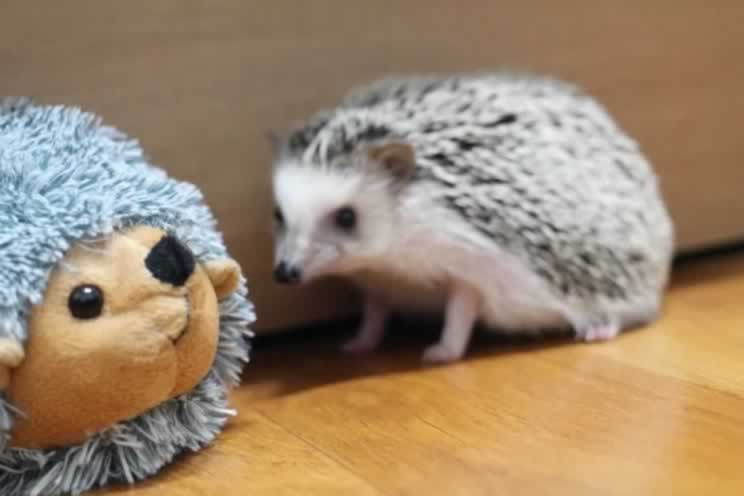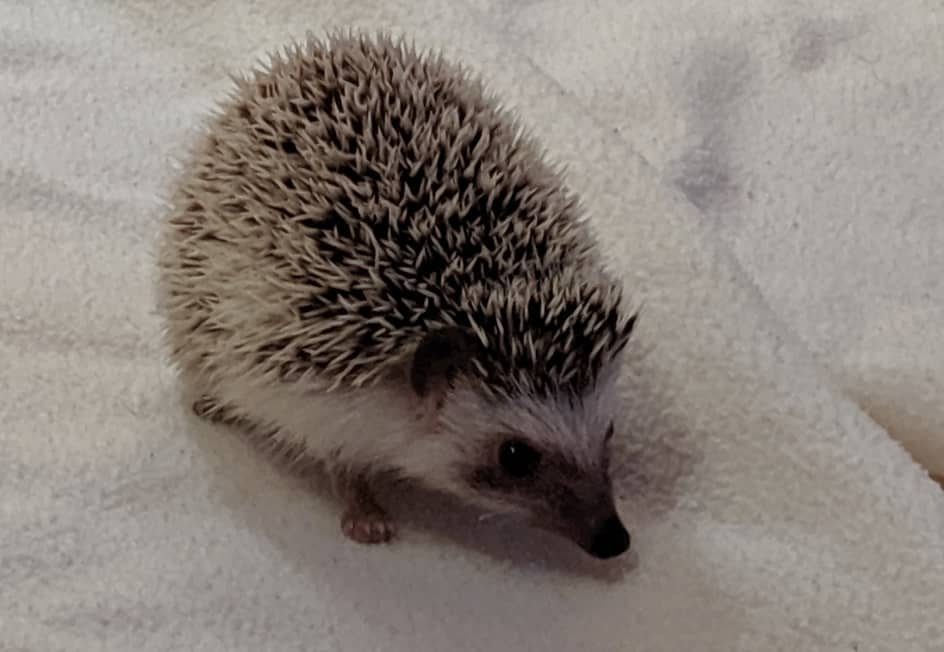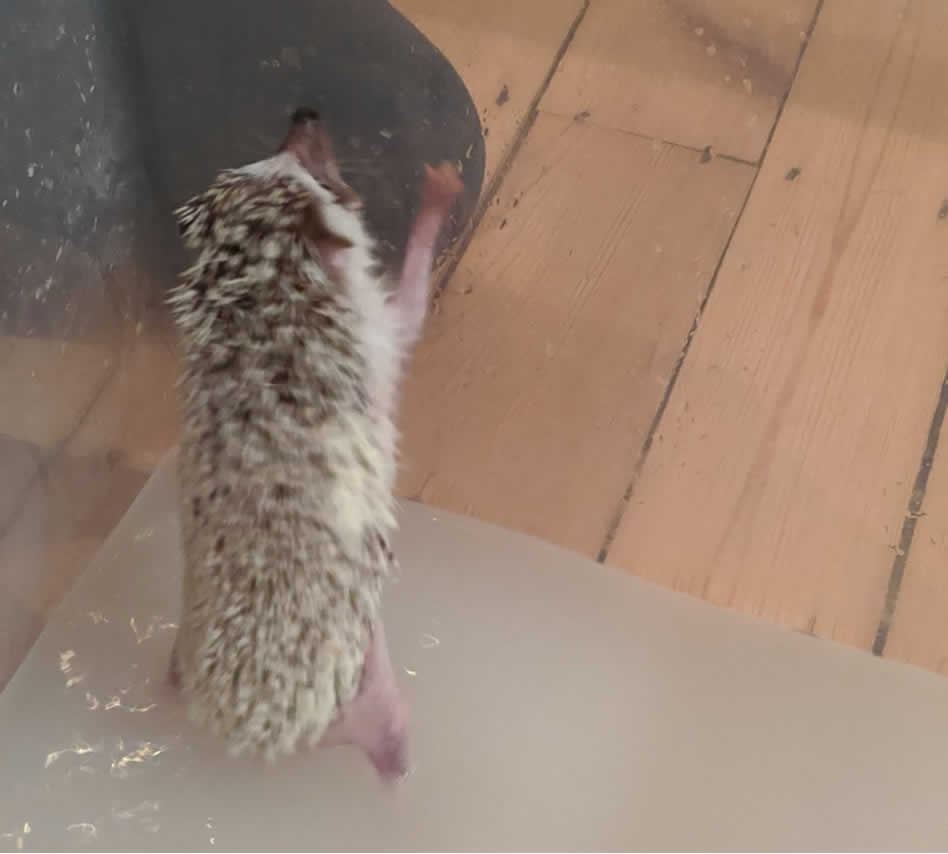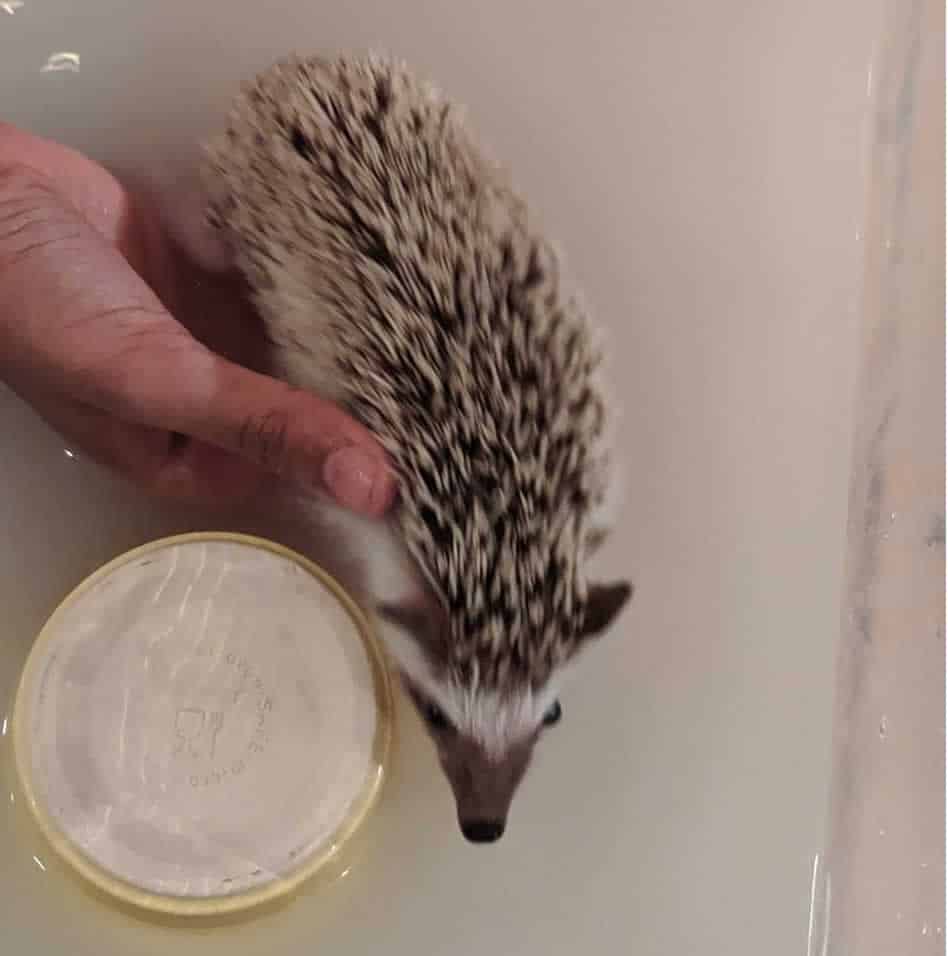
Pet hedgehogs just like many other hedgehog species can grow very quickly and we were amazed at just how fast our hedgehog Hynee grew. From the first time, we saw him as a baby to a month or so later when we picked him up to take him back to our house.
How big does a hedgehog get? Pet hedgehogs on average can grow to around 6 inches (around 16 centimetres) in length by the time they reach adulthood in around 6 months, with some hedgehogs especially pregnant females being considerably larger even after having given birth
They typically weigh between 10 to 17 ounces (300 to 500 grams) but can weigh more naturally or if they are not looked after properly by their owners (fed incorrectly or not allowed to exercise).
Pygmy hedgehogs are smaller than some of the other species of hedgehog and this had made them popular pets, as people find their smaller size cuter and much more manageable in comparison to the larger hedgehog species like the European hedgehog.
What is the average size of a pet Hedgehog?
On average when fully grown a pet hedgehog is between 6 to 8 inches (around 15 to 20 centimetres) long and this can be seen when they are fully uncurled and relaxed.
With our hedgehog Hynee, he’s about 8 inches long and he is able to fit into my daughter’s Jinnee’s cupped hands and my husband can nearly get him to fit on one of his hands.

However this is a bit of a misnomer, as to really see how long Hynee is, we need to see him fully uncurled. We have found when he’s in his bath and wet, with his spines completely down, you can see his thin elongated body and I think it would be a bit more difficult to get him to fit into Jinnee’s hands in his true size instead of being slightly curled in his normal position.

When you see pictures of him on this blog, it’s difficult to imagine him being about 8 inches in length but when he’s trying to climb out of his bath, as he initially tends to do, he stretches out to his total length and looks slim and quite elegant I must say.

Compared to some other species of hedgehog such as the European hedgehog they are not as big and therefore weigh much less. I remember taking my daughter Jinnee to a local zoo where they had a hedgehog protection centre and we were introduced to European hedgehogs.
The one the zookeeper was holding was massive, this hedgehog was about five times the size of Hynee and I vividly remember the size of this hedgehogs claws, they looked lethal. Hynee’s claws are tiny in comparison and look like they couldn’t do any harm to anyone but this other hedgehog’s claws looked like they could do some serious damage.
The female pygmy hedgehogs are generally a little larger than her male counterparts, I’ve not been able to find out why this is. I remember when we first went to see Hynee as a baby at the breeder’s, we were overcome how big the mother hedgehog was, more so as she wasn’t pregnant and had already given birth.
We also saw Hynee’s dad who was kept in a separate cage and he was smaller than Hynee’s mom, much smaller. We asked whether the difference was uncommon and the size of Hynee’s dad was an exception as he was much smaller, but we were advised this wasn’t necessarily the case and some females will always be much larger than their male counterparts.
Female pygmy hedgehogs do get larger as expected when they are pregnant, especially as they are carrying multiple babies, in fact, they could be carrying anywhere up to ten babies. I’ve seen many YouTube videos where the pregnant mother hedgehog is very large.
How quickly does a Pygmy Hedgehog grow?
As babies, during the gestation period (when they are growing inside their mother) they can grow to be ready to be born in around 30 to 40 days[2]. When they are born they weigh about a third of an ounce (around 10 grams) and are totally reliant on their mothers for the first few weeks of their life, feeding on her milk.
They are not able to see when they are born and are not actually blind, but just keep their eyes closed until around two weeks after birth when they are able to open them.
In the first month after birth, the baby hedgehogs rely on their mother’s milk and they are quite vulnerable at this time as their spines are still soft (initially after birth their spines are covered in a membrane to protect the mother) so they remain close to their mother.
In the wild, the mother would have found a secluded nesting area, safe from predators. We first saw Hynee after he was a few weeks old and he was about two inches long (five centimetres) and when we picked him up a few weeks later he had grown substantially to about three times the size.
At this time, his spines were stronger and he had spent the few weeks since we’d last seen him learning from his mother how to forage for food, which in this case meant finding the food bowl and eating the cat biscuits and finding the water bowl and drinking water.
In the wild, at this time, pygmy hedgehogs will learn to hunt for insects but can still supplement their diet with their mother’s milk but as they grow they will wean themselves off it.
It’s amazing to think from when they are born to when they leave their mother and become totally self-sufficient, a pygmy hedgehogs time with their mother is short compared to other hedgehog species.
Two to three months doesn’t seem really that long a time to leave their mother and go and forage for themselves spending the rest of their days living a solitary lifestyle but it works well in the wild and in captivity as pets.
Are they fully grown when they leave their mother?
Not quite, even though they have left their mother and gone to live a solitary lifestyle after two or three months of birth, they are still not fully grown and will keep on growing for a few months more.
How long until Hedgehog is fully grown?
Hedgehogs generally keep growing for about six months and compared to other hedgehog species the African Pygmy hedgehog (also known as the four toe hedgehog) reaches adulthood quite quickly and is sexually mature in as little as two to three months[1].
Even at six months they can still grow a little more and fill out but it’s important to make sure any of the growth isn’t attributed to a poor diet, causing weight gain and obesity.
How long are Pygmy Hedgehog legs?
Pygmy hedgehogs tend to have stumpy legs about two inches long (five centimetres) when fully grown and these look quite odd in size compared to the rest of their body but these are still quite effective in carrying them around and when running.
I’m amazed at how quickly Hynee can run on his exercise wheel with such short stumpy legs and how fast he can run across a room. We have to keep an eye on him, to make sure he doesn’t run underneath the sofa and try to hide there.
How do you know if your Hedgehog is overweight?
There’s a natural growth and then there’s unnatural growth from weight gain and obesity. As it’s not natural for hedgehogs to become obese they end up suffering from many health issues as a result.
In the wild, they tend to remain slimmer and fitter spending a lot of time each night looking for food, resulting in them covering large distances over a couple of miles.
They can eat a lot more fattening foods like insects in the wild than they can do when kept as pets because they have ample opportunity to burn off the extra calories and there may also be days when they do not find enough food, helping them balance out days when they may have eaten a lot more fat and calories against days of near starvation.
Our pygmy hedgehog Hynee looks a little overweight when you see him and initially, I found this a little troubling but when we bathed him and his spines and fur went completely flat with the water.
I could see he’s actually not overweight but is slim and it was the puffiness of his spines and fur that made him look overweight. It’s quite funny seeing him twaddle along and he looks as though he’s doing this because he’s a bit pudgy but it’s his natural gait and when he runs, it’s really cute the way he darts across the room.
5 tips to avoid obesity?
1. Weigh hedgehogs regularly
Bathing a pygmy hedgehog and seeing how they look when their spines and fur are flat is one way but the best way to see if they are overweight would be to weigh the pygmy hedgehog and then periodically repeat this to see if there is any change in weight.
I wouldn’t weigh a pygmy hedgehog until they are at least six months old (subject to them being fed and exercised correctly) as they are still growing, so any weight gain is natural expected weight gain.
Regular weighing can also detect any drop in weight as they may be eating less due to an illness, so medical attention from a suitably qualified veterinarian may be required.
2. Feed hedgehogs correctly
It’s only when they are kept as pets do they become larger through weight gain when fed incorrectly by their owners or where they have limited access to burn calories, such as an exercise wheel being present in their cages.
They also get the opportunity to eat every night as food is plentiful, making it essential to give them the right balance of food to ensure they can eat well but not end up putting on too much weight.
We feed our pygmy hedgehog Hynee within the guidelines of low fat, protein controlled diet using dry cat biscuits, with the indoor variety of these biscuits being an excellent balanced source of fat and protein.
3. Plenty of exercises
Hynee has plenty of opportunity for exercise too, as he has an exercise wheel to run on in his cage and he spends many hours late into the night and early morning running on his wheel, periodically coming off to quench his thirst and eat his dry cat biscuits.
4. Minimize on treats
Treats such as insects should be used sparingly as these can lead to weight gain and obesity. Obesity can lead to many health issues from diabetes to potential cancers, as well as damaging bones from the additional weight that needs to be carried.
Check out my food guide for tips on a healthy diet for pygmy hedgehogs.
From what I’ve seen about obesity across many forums, it looks as though pygmy hedgehogs are quite prone to diabetes and the associated diseases are not something I would want any pygmy hedgehog to experience, so it’s important to control their diets to minimize any chances of getting diabetes.
Another consequence of becoming obese is that fat doesn’t just build up around a pygmy hedgehog’s belly area but fat gets deposited all around their body. The fat that can build up behind their eyes can be very dangerous as it can push against their eye in its socket, causing the eye to pop out as a prolapsed eye.
This leads to the eye being damaged forever and it needs to be removed by a qualified veterinarian. This is sad to see, as this is totally avoidable if the owner takes care of what they feed their hedgehog.
5. Find out if the Hedgehog is a gorger
Pygmy hedgehogs can gorge on food and eat a lot more than they should be eating, this gorging leads to weight gain and results in them becoming obese. Obesity is not a good state for any pet to be in and as stated earlier, can result in hedgehogs suffering a number of health problems from diabetes to cancers.
Some owners just don’t appreciate the diet they are providing their pygmy hedgehogs just isn’t doing their pet and is causing the pet serious harm instead.
They assume just because pygmy hedgehogs love mealworms then it’s fine to let their pets gorge on these regularly and then wonder why they’re hedgehog is getting fatter.
Even some varieties of the dry cat biscuits contain four to five times more fat than the normal indoor dry cat biscuits and feeding these regularly will lead to weight gain and obesity.
Certain foods induce crazy gorging behaviour especially insects like mealworms. Whilst mealworms provide a source of chitin, they should only be given in moderation. They are akin to what candy is to humans, with moderate amounts being acceptable and anything more being terrible for their well-being.
Other foods they can eat quite happily in moderation as we found out with dry cat biscuits. Our hedgehog Hynee only eats enough until he’s full but this might just be a unique behaviour from our hedgehog and it’s important to keep an eye on what your hedgehog is eating.
How do I know if my hedgehog is underweight?
Weighing should give a good indication of the hedgehog being underweight when compared to previous weight readings but if you don’t know what is the correct weight for a hedgehog then it can be difficult to ascertain whether the hedgehog is underweight or not.
Underweight hedgehogs would require veterinarian investigation to make sure there’s no underlying illness causing weight loss.
Trying to give them foods with more calories may sound like a sensible idea to give them an opportunity to gain weight, but this needs to be balanced with any delay in medical treatment stopping or prevent certain diseases from progressing.
I tend to watch Hynee being held in my daughter Jinnee’s hands and see him when he’s put on his back (I can’t hold him with his spines on my skin as it hurts so much), if he curls up into a ball (where the length of the ball is near enough the same as the width of the ball) and his face is not visible then he looks fine to me from a weight perspective.
If a pygmy hedgehog cannot curl into a complete ball covering their face completely or where the width of the ball is much less than the height of the ball then these could be signs of the pygmy hedgehog being underweight.
It’s interesting to note when a pygmy hedgehog is overweight, they will also have a problem curling up as their fat would make it difficult for them to get into a ball shape and their face will be clearly visible.
Hibernation
Before going into hibernation a pygmy hedgehog could start to lose weight and this seems a little weird as you would assume a hedgehog would fatten themselves up before going into hibernation.
However, if it’s too cold for them because of substandard heating in their cage then their body can naturally assume it’s time to hibernate and it will start to slow their metabolism down, so they’ll be more lethargic and start to either eat less or stop eating altogether.
Hibernation is a dangerous set of affairs for a pet pygmy hedgehog as they will most likely end up starving to death if they fall into hibernation and are not promptly revived, as they simply won’t have enough body fat to survive the hibernation.
It’s important to make sure steps are taken to ensure they don’t go into hibernation and this involves ensuring they have enough heat to keep them warm and comfortable.
Pygmy hedgehogs love to be between 72F (22C) and 80F (26.5C), anything substantially lower can increase the likelihood of going into hibernation.
We have thermometer in Hynee’s cage and this checks the temperature in his cage when the thermometer falls below 72F (22C), the thermostat picks up on this and automatically switches on Hynee’s heat mat, so if he’s asleep or resting in his house, the heat from the heat mat will keep him warm.
We also have a minimum temperature set on our central heating, so if the overall temperature of the house falls to this temperature, the heating comes on automatically.
Keeping a pygmy hedgehog in a freezing cold room even with a heat mat can still push them into hibernation, as the rest of the cage will be cold and coming out into the cold to feed, which could cause their instinct to think it’s time to hibernate.
Darkness
Pygmy hedgehogs are nocturnal and come out at night in the darkness to feed and when the darkness is not there they may be reluctant to come out to feed and as result will start to lose weight.
Using the wrong heating such as heat lamp that emits light can confuse the pygmy hedgehog into thinking it’s still daylight and stop them from venturing out, so it’s important to use a ceramic heat emitter type heat lamp that only emits heat and not light to make sure the pygmy hedgehog comes out at night into darkness and not light.
How big do female hedgehogs get?
A female pygmy hedgehog is generally bigger than the male pygmy hedgehog and when they become pregnant they start to get even bigger as they are carrying several hedgehog babies.
With some litter sizes reported to be between four to six babies to some instances of ten babies, means the size of the pregnant female hedgehog can be quite large.
How do you know if your hedgehog is pregnant?
One of the first symptoms of an impending pregnancy will be the female hedgehog showing signs of weight gain and looking a little plumper. If the female’s diet hasn’t changed, that is, she hasn’t been fed more fatty foods like insects regularly, then any weight gain could be attributed to pregnancy (as long as she’s been in contact with a male pygmy hedgehog).
If this isn’t the case then the female hedgehog needs to be checked out by a veterinarian to ensure it’s not an illness or disease that’s causing the weight gain.
A change of habits such as a reduction in the amount of time the female spends on her exercise wheel could also point to her being pregnant, as she will be trying to conserve her energy for her growing babies inside her.
Exercise, when she’s pregnant, would seem futile as she wouldn’t need to burn off any excess calories instead she would need these to feed her babies growing inside her.
A pregnant female hedgehog may also start to eat a lot more than normal, so the dry cat biscuits may need to be replenished with a larger serving each night.
If we had a female pygmy hedgehog who was pregnant we would just fill out the feeding bowl with dry cat biscuits to make sure she had a plentiful supply of food and we would probably introduce one or two more mealworms per week, as these could give her a little energy boost.
Female hedgehogs will also start to prepare themselves for their pregnancy by creating a nesting area, they’ll try to move the bedding (if it’s removable like pellets) into an area or maybe even into their housing area to make it comfortable for her and her babies.
It’s best to get any female pygmy hedgehog checked out by a veterinarian (with experience of pygmy hedgehogs) to make sure she is healthy and doing fine.
In the wild breeding is usually done in the summer months between May and August, as not only is the temperature warm, there is also an abundance of food in insects. If the breeding is done later then the baby hedgehogs may struggle to survive as it’s colder and food may not be readily available.
When kept as pets, the breeding doesn’t need to cater in the seasons as the temperature and abundance of food are controlled by the breeders, so the survival chances of the babies are much higher than in the wild.
How long do hedgehogs live as pets?
Once fully grown at around six months, a pygmy hedgehog can live for around another eight to ten years[2] but realistically it’s more likely to be three to five years, as diseases like cancer are common.
This is more than they would do in the wild, as in the wild they only live for half as long as they succumb to predators and can also die from starvation due to food shortages.
Related Questions:
How much are hedgehogs? Pygmy hedgehog prices vary considerably between private sellers, pet stores and specialist breeders. We paid $350 for our pygmy hedgehog from a specialist breeder and could have paid less if we’d have used a private sale but we wanted the assurance of having expert advice available from a good breeder on hand.
Can hedgehogs choke? Yes, pygmy hedgehogs can choke, so it’s important to be extra vigilant when feeding them something other than their usual dry cat biscuits. It’s best to minimize foods that are hard to break down with their teeth or are too sticky, as these can also get stuck in their throats.
[1]https://en.wikipedia.org/wiki/Four-toed_hedgehog
[2]http://www.rosamondgiffordzoo.org/assets/uploads/animals/pdf/AfricanPygmyHedgehog.pdf

